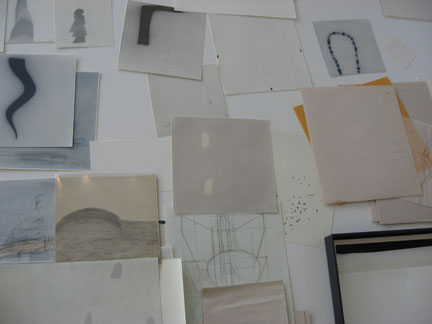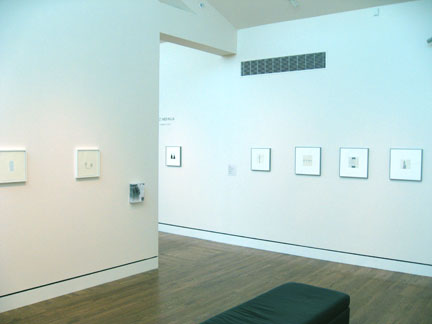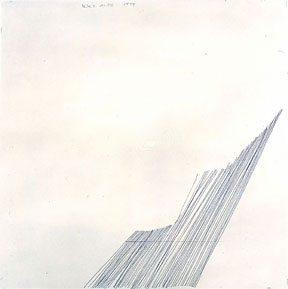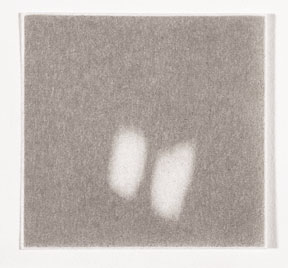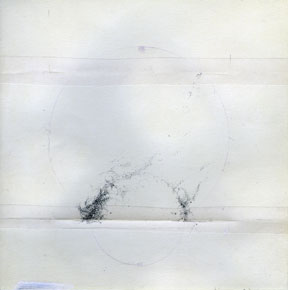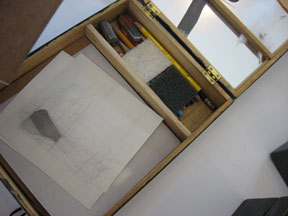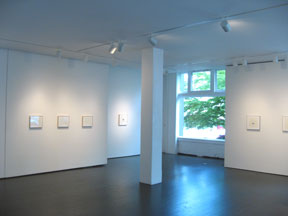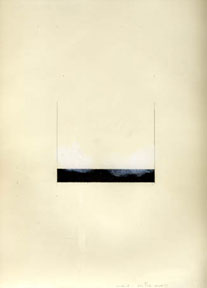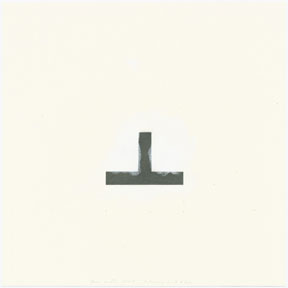
|
||
|
Portland art blog + news + exhibition reviews + galleries + contemporary northwest art
|
||
The Material World- APEX :Wes Mills at the Portland Art Museum and Wes Mills: Drawings at PDX
A pencil, some white powdered pigment, a couple of pieces of paper and an open mind. You can't get much simpler than that, but when Wes Mills started drawing again in the early 90's that was as good a starting place as any, because what he was looking for was within. Starting with a limited palette of raw materials, and therefore fewer variables, Wes felt like he could get closer to the experience of art. When I look at his drawings, I am reminded of the Zen archers who find that they are aiming at themselves in the center of the target. In Wes' case, I think he finds himself in his materials. The drawings are not the object but the results of that exploration. To put it another way, the drawing becomes the vehicle for the transmission of thought rather than the object of the experience. The concurrent shows at the APEX: Wes Mills at the Portland Art Museum and Wes Mills: Drawings at PDX Contemporary are the results of this process.
Why did Wes feel the need to restart his work with an open mind? Maybe it is because sometimes if you have an idea it takes you out of the moment of the experience. If one approaches a work without an idea, you are encountering the work with a fresh eye without any preconceptions or expectations. You can be totally be in the moment and learn about the materials by what the materials tell you rather than what you have learned. For example, let's look at what a pencil can do:
For these drawings if you only look at the image, you get less than half the picture. If you were only to look at the horizontal lines or grids in Agnes Martin's work or if you only saw the zips in Barnett Newman's work you miss the point. The important thing about seeing these artists' work is your individual experience at that moment. Similarly when Wes draws a line, he is not illustrating a line but communicating about the experience of making a specific line, in a specific location on a specific piece of paper. That is the experience of drawing and why his drawings are so engaging. Every decision becomes important and the accumulation of these decisions creates the drawing. I think that is why the drawings are so intimate, because everything is revealed and you are left to experience his decision making process.
If you look at the drawings in the APEX gallery (curated by Jennifer Gately) one witnesses the variety and the freedom that he has found within such limited means. The works span a seven year period from 1994 to 2001, although some of the travel boxes are as late as 2004. Walking through the show the viewer can experience how Wes learned to strip away everything that was not essential to the drawing. The earlier drawings tend to be more worked over while in the most recent drawings he seemed often content with a just a line or two. It is not uncommon to see two of the same type of elements in these drawings: two lines, two shapes, two eraser marks, etc.. I believe this is Wes at his most interesting because it creates an intense dialog about the authenticity of the not only drawing but also the experience of drawing. When is a form or mark an original? If the same form is repeated is it a copy or is it also uniquely authentic? What does it mean to be authentic? These are types of questions that allow you to move beyond the images on the drawings and move into a deeper sense of questioning that Wes experiences every time he picks up a pencil. The forms on the paper are just the means for an ongoing dialog about the experience of drawing and not the end product.
When I look at a drawing like No Title from the series Shore Line at PAM, one of the first things I noticed was Wes' ability to change the plane of the paper to suit the needs of the drawing. Usually artists will either take the surface of the drawing as a given to which the drawing is applied, or in the case of collage, they would cut paper and layer it in such a way to create a new image or space. In No Title, he cuts the paper to define the locations of the two circles and the razor blade and it becomes another way to make an edge, or to transform the paper to suit the drawing. The razor blade becomes as essential to drawing as the pencil. To me that is very revealing of his process because it means that every material and tool is questioned and that there are no givens that can't be changed to suit the experience. Sometimes when you look at his drawings there is also the unnerving feeling that the forms are shifting in time as well as space.
It was enlightening to be able to look at his travel boxes installed in a clear case at the beginning of the show. They give the drawings a human touch by revealing some of the tools and maybe a little about how he actually creates the marks on the paper. Sometimes it is a pencil, other times there is an eraser, and occasionally even a penny are used to make marks on a drawing. Looking at the tools you can see how well worn they are and you get a feeling for a how much a drawing is slowly worked over until it finally resonates. I was surprised to a see a beautiful box of small curved plexiglass templates that are sometimes used like a set of French curves. It meant that even the most organic lines in the drawings are potentially repeatable.
The drawings at PDX remind me a little of Newman's Stations of the Cross, where a theme is developed, explored, and sometimes expanded to create a complex variety of work with very simple materials and with austere constraints. As you walk around the show, you can see that sometimes the dark shapes of the pencil take all kinds of forms. Sometimes they are just the skeleton outline of a rectangle or an inverted "T" shape. In other drawings these shapes are filled in to in crystallize the relationship to the white pigment. Sometimes lines that look they are drawn with pencil, are actually small cuts with a razor the break the plane of the paper. This white pigment seems to be applied by hand and you can often see white finger prints dot the edges of a drawing. The pencil is applied within a set of distinct coordinates and might be drawn with a ruler to heighten the contrast to the softer white pigment. It is interesting to see how the pencil lines and the soft billowing forms of the pigment come to define and transform one another.
Some of the most interesting drawings are those that just have a line a two. Sometimes the lines barely cross and so from a few feet away you are not sure if it is one line or two. Other times a line is drawn, only to veer off in another direction. While looking, I found it helpful to refer to Gately's excellent interview with Wes in the pamphlet produced for the APEX show. In the interview, Wes describes that drawing a line is sometimes equivalent to having a thought, and that thoughts as well as lines eventually go off in another direction. In the case of these drawings, the lines might represent a thought process as well as the experience of making those very same lines so the interaction of the two becomes very complex.
The shows at PAM and PDX are an excellent compliment to one another. It was interesting to see how the evolution Wes'drawings over seven years and it was great to see the travel boxes which almost tell you as much about him as his drawings. At PDX, we get to see how his work develops practically from drawing to drawing when he is working with a specific experience for over a year. I was impressed with the variety of marks that can be made when you concentrate on the different ways that materials can be used to suit your needs. It was also encouraging to experience how the act of drawing and the transformation of those materials can convey meaning. Apex: Wes Mills
Posted by Arcy Douglass on July 23, 2007 at 15:19 | Comments (0) Comments Post a comment Thanks for signing in, . Now you can comment. (sign out)
(If you haven't left a comment here before, you may need to be approved by
the site owner before your comment will appear. Until then, it won't appear
on the entry. Thanks for waiting.)
|
| s p o n s o r s |
 |
 |
 |
 |
 |
 |
 |
 |
 |
 |
 |
 |
 |
 |

|
Site Design: Jennifer Armbrust | • | Site Development: Philippe Blanc & Katherine Bovee | |


